Radon Reduction From Basement Sealing – Preliminary
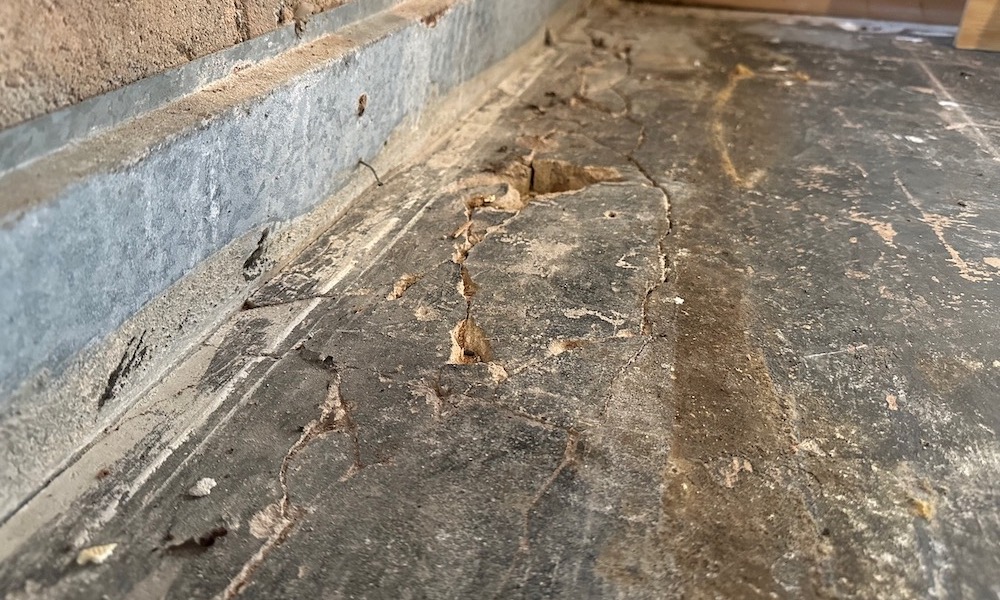
Shortly after my wife and I bought our 1961 home in 2019, I discovered a serious problem in the basement. Where I could see it, the slab was cracked all along the edge of the exterior walls (photo above). I figured it might be causing elevated radon in my house, so I did what any normal person would do. I avoided testing my radon level. Until last spring, that is, when I found it was above where the US EPA says you should fix it. Now I’ve finally started doing something to get some reduction in our radon level.
What was wrong with my basement?
After doing a 7 day radon test in early April last year (2023), I dug into those cracks in my basement slab. You can see below what I found. Beneath the cracked slab was a piece of plastic sheeting. Beneath that was a layer of granite chunks. And beneath that was a corrugated plastic pipe.
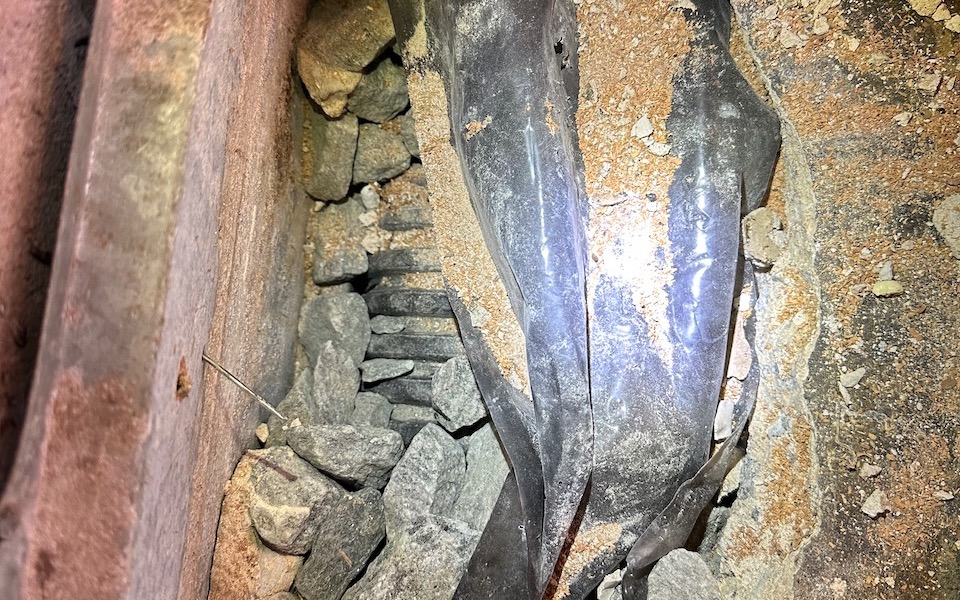
Yes, this was an interior perimeter drain system installed decades ago, but after the house was built. In addition to the cracks in the slab allowing soil gases to leak into the house, that piece of metal wasn’t sealed either. In some places, there were large gaps at the top edge or between it and the slab.
And then there was the mystery hole I saw shortly after we bought the house. That’s red Georgia clay you see in the middle of hole. Because it’s in a closet near the middle of the basement, it couldn’t be the same problem I had at the perimeter.
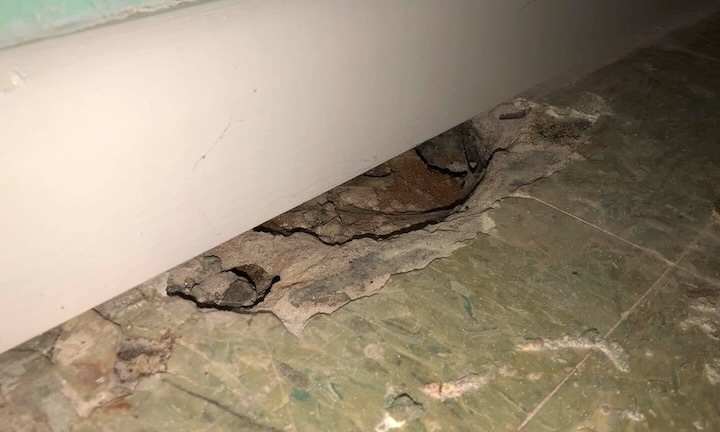
After getting the drywall removed, I discovered the reason for that mystery hole: a plumbing drain pipe that was added during a renovation after the house was built.
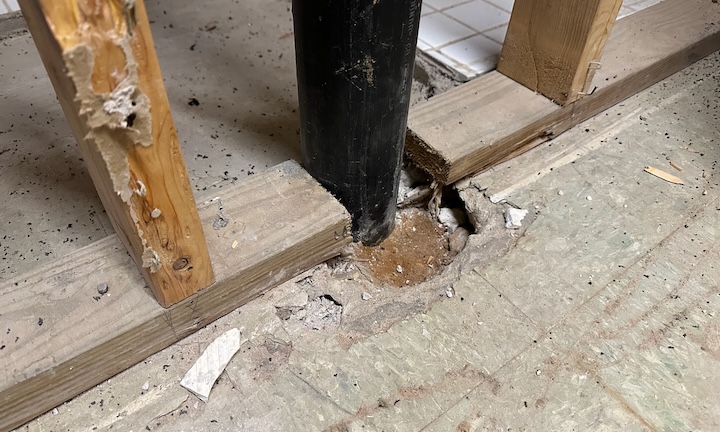
That hole is still open, but I’ll fix it after I remove that interior wall and get the bottom plate out of the way.
Soil gas leak sealing, so far
The first part of the basement renovation exposed the basement to more soil gases because we opened up the slab in multiple areas. But we also separated the basement from the house with plastic sheeting and put in continuous ventilation to exhaust air from the basement. (You can see the fan in the window below.)
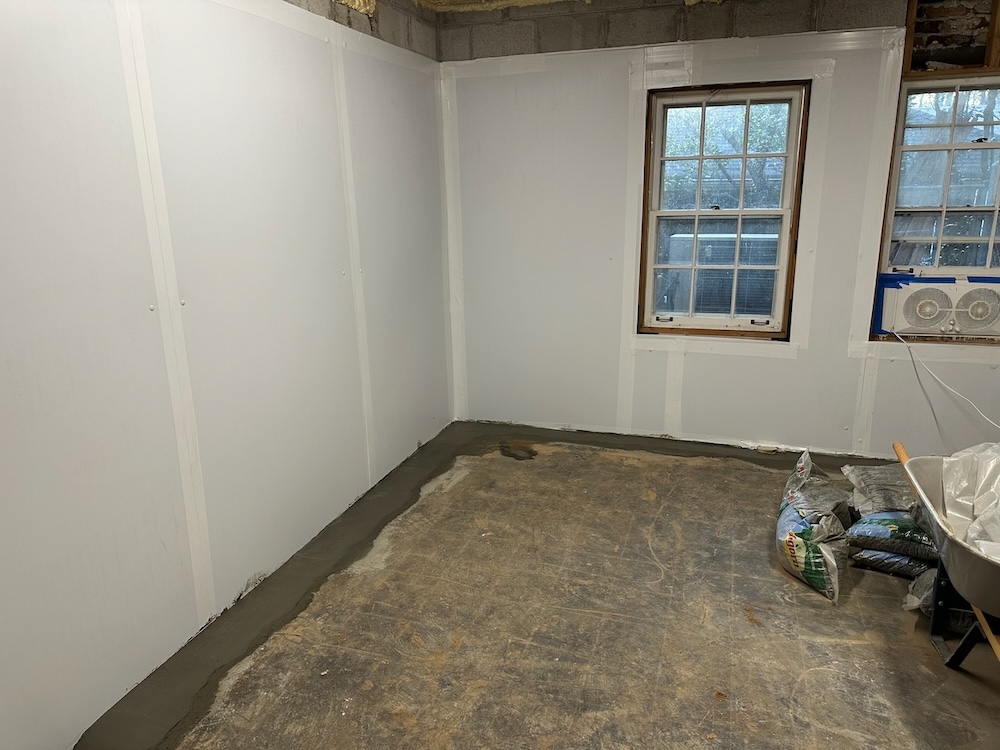
But since then, we’ve been closing up the slab and the concrete masonry unit (CMU) foundation walls. The photo above shows the new concrete over the new interior perimeter drain. And the plastic on the wall is sealed with tape and polyurethane sealant (mostly).
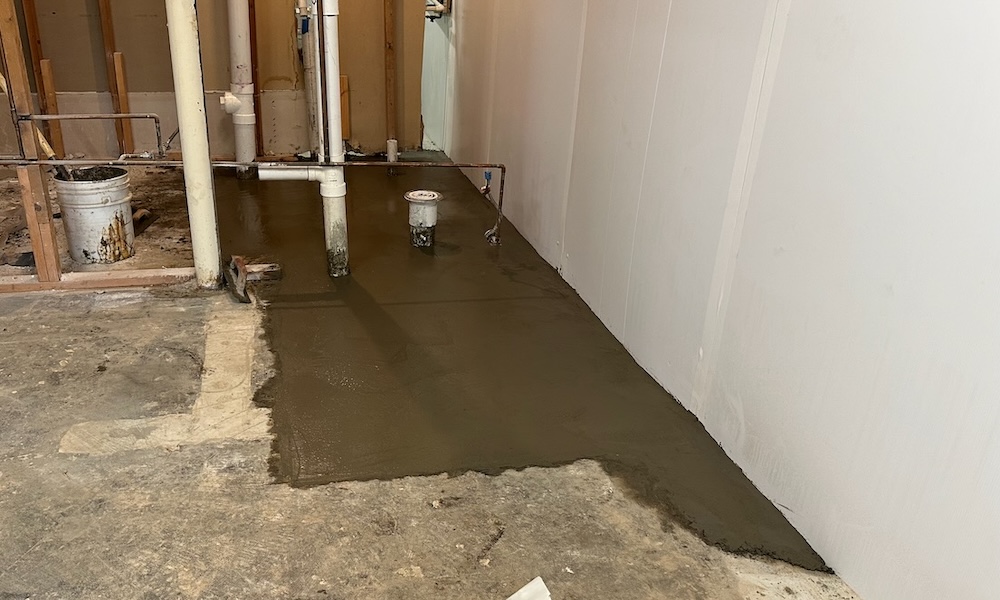
Then last week, the concrete contractor came and covered up the big hole where the plumbers replaced cast iron drain pipes (photo above). They also dug a hole for a footing to hold a new column that’s going in and then filled the hole with new concrete.
So, there’s a lot less leakage area for soil gases to get into the house.
Radon level timeline
Now, how has the radon responded during all that’s happened? You’ll see the graphs in the next section, but let me provide a general timeline here of my radon measurements and basement status.
Early April 2023. Did a 7 day radon test and radon level was 7.7 pCi/L. Tested main floor, not basement.
20 May through 23 Sep. 2023. Alpha track test resulted in 10.3 pCi/L of radon. Tested basement.
13 July 2023. Installed Airthings Space Plus continuous radon monitor with sensor on main floor.
27 May 2023. Opened old perimeter drain in one room of basement.
9 Feb. 2024. Basement renovation started with day of demolition.
27 Feb. 2024. Basement slab closed up after replacement of perimeter drains and new concrete over other work.
That will provide the context for the radon level graphs below.
Early radon reduction results
The first graph here shows our daily average radon level since I put in the Airthings monitor on 13 July. Before the renovation started, we were averaging pretty much the same radon level I got in my 7 day test last April: 7.7 pCi/L. With the recent reduction in radon level, that average is now down to 7.4 pCi/L, as you see below.

Looking at the radon data over a shorter time period, the past month, we can see that the radon level dropped about ten days into the basement renovation (~19 Feb.). After the slab holes were filled last week, it dropped even more.

The 48 hour graph below shows several periods of the radon level staying at 0.0 or 0.1 pCi/L for hours at a time. Wow!

So we have some significant radon reduction going on here. But…
Is it too soon to declare victory?
Yes, absolutely! It’s definitely too soon to declare victory. First of all, the house isn’t in its normal state because of the basement exhaust ventilation and the plastic sheeting separating the work zone. Also, things change seasonally and with weather patterns. Notice in the first graph that we had a couple periods of low radon levels last September and October.
But, I definitely have reason to be hopeful that there’s some significance in the radon reduction I’ve seen already. The lows we had last fall bottomed out at 2.0 pCi/L whereas the recent lows have been 0.0 pCi/L. Also, I still have some sealing to do. I had to remove some of the wall plastic and haven’t resealed those edges yet. And there’s the closet hole and a few other little places still to seal, too.
I didn’t expect to see such a dramatic and quick reduction in my radon levels at this stage, but it makes me happy to see where we’re at now. And it provides (with the caveat of needing more data) some justification for all the money we’ve already spent on this project.
Radon update, May 2024
After I published this article in March, I made an accidental discovery. In the second section above (Soil gas leak sealing, so far), I mentioned the exhaust fan I’ve had running in my basement since I began this project in February. Well, I turned it off one day and then forgot to turn it back on until the next day.

The graph above shows what happened. The radon level spiked up to 12 pCi/L. When I turned the fan back, the radon level dropped back to the safe level. So it seems that the slab sealing I’ve done so far may not be the reason for low radon levels for the past few months.
Stay tuned. I’ll let you know what happens when the basement is all done and the temporary fan removed.
Allison A. Bailes III, PhD is a speaker, writer, building science consultant, and the founder of Energy Vanguard in Decatur, Georgia. He has a doctorate in physics and is the author of a bestselling book on building science. He also writes the Energy Vanguard Blog. For more updates, you can subscribe to Energy Vanguard’s weekly newsletter and follow him on LinkedIn.
Related Articles
What to Know About a High Radon Test Result
Does Radon Really Cause Lung Cancer?
Basement Renovation in a 1961 Home
Comments are welcome and moderated. Your comment will appear below after approval.
This Post Has 38 Comments
Comments are closed.

Allison, I really like the caveat “needing more data.” It shows some real clarity of thought. Chasing radon is often not fun and very expensive but it doesn’t have to be. Did you track the relative house pressures during the test periods?
Thanks, Walter. Yes, the Airthings Space Plus monitor also measures atmospheric pressure so I’m hoping to find some interesting relations there.
I owned a house in Fraser Colorado that had a crawl space completely lined and sealed with plastic sheeting. My radon level in the house was 10 PC/L. I installed a fan to pull air out from under the plastic and it dropped to 1.7. My opinion is that sealing alone will not make a significant difference in indoor levels.
Airthings follows my home’s air quality. I installed the UGA passive system in my slab but needed to add fan in attic to 4 in PVC to get radon below 2 consistently. Oddly my bedroom has higher levels of Radon than the basement as the radon pipe passes through the wall with the fireplace chimney. Perhaps the PVC pipe wasn’t sealed well.
Nice explanation. I found an interesting new tool to help prevent concrete cracks from spreading. It called Stitch, it’s a carbon fiber and Kevlar strip about 10 inches long you cut the concrete perpendicular to the crack insert the stitch and then fill with epoxy. The samples I got at a trade show have worked fine in my driveway.
I also use a densifier that significantly hardens the top inch or two that prevents spalling and dust. I then seal it with either a water or oil prevention penetrating sealer and leave the concrete raw rather than putting epoxy or other coating on top. It keeps the slippery when wet from getting to bad. If you are going to stain the concrete do it before you add the sealer or it will just bead up.
If the contractor didn’t drill into the existing slab and install the metal rods or other hooks that are normally used the stitch product will lock them together.
I’ve never had a basement to deal with so I don’t know if the densifier and sealer will help with Radon or not.
David: Thanks for the recommendation. I’ll check it out. And yes, they did drill holes and use rebar to connect the new concrete with the old.
I enjoy having an Airthings in my home that I can move room to room.
Curious how you calibrated the Airthings Space Plus IAQ monitor or did you later also send samples for outside lab analysis?. Manufacturer specs indicate it’s more of a qualitative rather than a quantitative measurement.
John: I haven’t calibrated it. But it has agreed with the 7 day charcoal cannister test I did last April and probably the 4 month alpha track test I did over the summer, too.
I’m interested to see your readings of 0.0 pCi/L. From my experience background radiation in the atmosphere is around 0.4pCi/L. I have gotten similar readings from my Airthings monitor if I leave it outside for a day ot two.
In the basement of the house I get long term readings of 1.0 to 1.4 pCi/L with an underslab extraction fan on 24/7. Before I installed the fan it was 5-7 pCi/L.
M Nevans: If you look at the bottom graph of the 48 hour timeframe, you’ll see at the very end that it says 0 pCi/L at 6:00 am. All the places in that graph where it’s hugging the bottom are either 0.0 or 0.1 pCi/L.
There is, of course, uncertainty in all measurements, so I’m not relying on short term looks at the results from my continuous monitor. I’ve also done other types of tests and will do more when we finish up the basement renovation.
Very nice reporting on your Radon mitigation job! I have been using the AirThings View Plus to monitor radon, however I cannot see any correlation of radon levels to anything except outside air intake which flushing it out.
This IAQ device is also very helpful to monitor changes to my attic duct system, HVAC fan run time, outside air intake, and filter MERV changes – very interesting.
Thanks, Bruce! Yeah, finding correlations takes time. Proving causality takes even longer.
Since you have the airthings, and mechanical ventilation to the basement, you might be interested in repeating some tests I did that go against the common knowledge with ventilation and radon.
I have a complex basement/crawlspace combo at my 1910 built house that prevented us from installing traditional subslab radon mitigations. We had an erv installed to exchange exterior air which is the common knowledge approach to spaces like ours.
I was interested in reducing the energy use so ran a series of tests over a couple months or so. I tested both fans on high/low, exhaust only on high/low, and supply only on high/low.
Results came from an airthings wave located in the basement. As you’re aware, there are seasonal fluctuations, and heavy rain, hotter weather (I theorize stack effect pulls makeup air from the basement), and atmospheric pressure all have significant effects on the seepage of radon from the soil.
Exhaust only was easily the worst performer in my test. I think it’s because you’ve effectively created a “reverse” mitigation system. Depressurizing the basement with exhaust only draws more radon from the soil which will be at a slightly higher relative pressure. A well sealed slab might instead draw makeup air from the living space above though. My crawlspace is open dirt (working on correcting that).
Next best was balanced intake/exhaust. This is the traditional mitigation method for places that can’t do sub-slab.
Surprisingly, the best performer was intake only, and constant low fan speed was enough to keep things below 0.5 pCi/L (basically atmospheric). I’m thinking that this serves to slightly pressurize the basement above the average soil pressure which helps to mitigate seepage of radon. There’s a possibility that this may effect the overall building energy envelope. Without detailed data to prove it, it seems like at least at my house it didn’t have a noticeable effect in my energy costs.
I took things a step further and hooked my wave up to a home automation that turned the intake fan on (via a smart plug) when radon levels were above 3 and off when they were below 1. This keeps the year long average at ~1.8 which is below the epa actionable level. If I wanted I could set my upper and lower limits differently to reduce things further.
With the changes, I’ve reduced the cost of running the system by 75% or so. I’ve completely eliminated one fan, reduced the second to a slower speed, and cycled it on/off to only blow when needed.
I think this is an underesearched method and my results seem to contradict the epa guide (which states that active pressurization is the least attractive method).
I’d definitely be interested in a followup article looking at the effects of reversing your fan and pressurizing your basement.
This comment gives me hope as I didn’t want to have more roof penetrations and my stone house with large overhangs would create a terrible eye sore for a standard system. I still need to install the erv, but I was hopeful that I could slightly pressurize the basement when installing the Erv and reduce the gas by not pulling in as much and also diluting it/extracting it.
This honestly seems like a better starting point because of the values of fresh air overall. Maybe others will start doing this more if there is more study of it.
Our Zehnder ERV is installed near a corner with the intake and exhaust on perpendicular exterior walls.
The house we had in Nashville was the perfect site for the first test in 1988 (?) and we did a simple sub slab suction with continuous fan. Then, in New Jersey we had a home buyers test on a Clear Blue Sky Day. So, when we go to sell two years later, the buyer has the test and RADON!. After living there for 2 years I was pretty hacked. The tech says it was a Blue Sky Day. There’s a data point. We had to put in sub slab suction to sell.
My new solar house has the pipe in place just in case I decide to test on top of a ledge in the Green Mountains. BTW the Greens are the oldest volcano range in the world and New Hampshire was another continent that slid into place so the soils and mineral uptake are very different. VT’s better.
Thanks!
Interesting, but besides needing a better basement floor and wonder why you did not do something earlier since you are an architect interested in a better home is it really necessary. From 1976 until 2004 I was an ‘environmental’ engineer with the Department of Defense living and employed, mainly, Oahu, Okinawa, Germany, and Japan. In Germany we tested for radon in U.S. base housing. This was an EPA requirement. I hear stories of military members testing their off base housing for radon. I hear of Germans going to radon treatments where radon is used for ‘therapy’ . In Japan, I do not remember this being a concern meaning we did not test. Over those decades I never heard of anyone being sicken by radon, and since graduate school did not teach any concerns with radon prior to my employment I did not worry about it. Radon was just a requirement for which we tested. More important items keep me occupied during my career that ended 2 decades ago. Since leaving and moving back home to the Pacific Northwest I have not heard of anyone concerned with radon. Is radon really worth time being concerned?
I have lung cancer. It was caused by living in a house for 22 years with a reading of 29. When we sold the house the new buyer wanted a radon check in.2022 By that time I was in the middle of my first treatments. Even by oncologists were puzzled since I had never smoked. In Northwest Arkansas the dangers of radon is not widely known. Our new house is safe to live in. I have done 2 radon tests the one checked the house over several months. The new owners did all the work that was done to make it safe to live in. That house was built in 2003.
Allison, another great posting. Should the “cove joint” along perimeter of basement foundation wall and floor be sealed? My search online of my 3 trusted go-to resources—GreenBuildingAdvisor, FineHomeBuilding, EnergyVanguard—yielded nothing on cove joints. But I find information about cove joints on countless basement waterproofing websites. It’s a mix bag: some recommend sealing while others claim that it’s a bad idea because it can lead to structural damage and water issues. The house is 2018 ranch in SE Ohio; 1600 sq ft first floor, 1000 sq ft basement: 1/2 finished, poured concrete floor, block wall, fb insulation covered with plastic on top half of wall, and sump pump (SP); grading around house is decent. At 3 year mark in house, a hard rain resulted in basement flooding with approx. 1/4” of water along perimeter of half of the basement. Contractor pointed out that sump pump wasn’t functioning: it wasn’t properly installed! No problems since fix. I would think that cove joint should be sealed (Not sure wha type?), preventing air and soil gasses from entering? Thanks
Allison like many radon professional’s I am 3 or 4 handed in my opinions about chasing radon. On this hand it is likely this but on the other hand it might be that or the other thing. I do learn, albeit maybe a bit slower than some other folks….. My mentor in the radon mitigation was Terry Howell from Atlanta, he own’s or owned Radalink (we have lost touch over the last few years). Terry used to tell me don’t spend anymore than a big bag of groceries would cost trying to seal radon out.
We have had customer’s spend a bunch of money and have radon levels go up in their home. When we installed a system and we sampled the radon levels below the slab they were almost 20x the level below the slab as they were in the home. What my team and I surmised from this was that they a significant source very close to the home and that when they sealed up all the openings that they could find, the radon levels went up in the sub slab and now the radon levels that were seeping in at a much higher level than they were before. Terry used to say tome Radon needs three things, a source, a pathway, and home with stack effect. As we build tighter and tighter homes Radon levels go up.
In your home you may want to check with a smoke pencil the top of the block to see if soil gas is seeping in and rising up the openings in the block. You can slow this process down by packing the top of the block with rock wool and then filling the top block with 2lb spray foam. But no guarantees. We had a different home in Northern Ontario home started at over 10,000 Bq/m3 or 270 pCi/l after 14 draw points and 4 trips we had it down to 180 Bq/m3 or 4.8 pCi/l. We added 4 draw points to the block walls and we were down to 87 Bq/m3 or 2.35 pCi/l . Most homes a standard radon sub slab decompression system (SSDS) that is covering 100% of the slab with a negative pressure of -.010 inches of water, will lower the radon levels in the home by up to 90 -95%. But your radon guy needs to do a communication test and be able to tell what the correct fan is for your home. My trucks now have 6 or 7 different models of fans, when I started out 19 years ago we only carried 2 models of fans. I look forward to more teaching and mitigating in the great white north. A great eclipse here today other than some cloud cover right at the zenith.
Ryan and Allison: I assume from the “cove joint” you are talking about the joint between the wall and the floating slab floor. this joint should be sealed with a flexible caulking. The caulking you select has the ability to expand and contract. this will protect from any concerns with structural damage from expansion and contraction of the floor slab. The caulking you select should have a low VOC level as you do not want to save someone from radon and expose them to another carcinogen. About the water concerns, yes that opening will save you clean up if a small amount of moisture is coming through the wall and draining down the opening but if you are going to finish the wall and add 2×4’s insulation and vapour barrier you will have a mouldy wall. Fix the water entry before anything else!!! Uncontrolled water entry is probably the number one cause of building failure. Your home is likely your largest investment why would you let water run in when extending the downspouts and fix any grading issues will likely solve the problem.
A happy side effect that we’ve noted was a reduction in basement (and crawlspace) humidity when radon fans were installed. I’ve found no formal peer-reviewed studies yet to support this, only anecdotal.
A happy side effect that we’ve noted was a reduction in basement (and crawlspace) humidity when radon fans were installed. I’ve found no formal peer-reviewed studies yet to support this, only anecdotal.
I’m late to the blog but I’m very interested in this. I bought my home in the early 90’s with a pre-installed mediation system. Periodically over the years I would do the canister test, and depending on weather/seasons/etc sometimes the levels were low, sometimes not so good. I then bought some EcoQubes so I could do better monitoring. I’m happy to report that only my unfinished basement has sometimes unacceptable levels. However, since I know these levels vary I want to make improvements.
I’d be happy to share screenshots of my findings from the EcoQube but I’m not sure I can post them to the blog. Having read some of the comments here and elsewhere, I decided to add a cheap power vent to pull outside air into the basement. This is a short term solution, because I’m not filtering or preconditioning the outside air. However within a couple of hours of installing the vent, on a very low airflow setting, my basement radon levels dropped from a typical weekly average of 3 pCi/L to 1 pCi/L. I ran this vent from Aug 23 until Sep 15. Within a couple of hours of turning off the fan my levels are back to results prior to adding the fan.
Why did I turn off the fan? Two reasons. First, I planned to run the test for several weeks to get a better sense of whether it was beneficial or not. Second, I’m in the Atlanta area and our humidity over the past week was extremely high due to the rain and my basement dehumidifier couldn’t keep up.
So now I’m looking for thoughts as to whether an ERV would generate similar results. Right now my fan arrangement is pulling in outside air, other than leakage there is no balancing of flow out. I inquired from my HVAC contractor whether I could get an ERV that pulls more in than pushing out and was informed they really aren’t designed to work that way, and it might not work as an ERV at all without the balance.
I’m not sure what other solutions are practical. I mean, I could add a filter box before the fan and a big dehumidifier after and that might help in the summer. But I’d still be pulling in hot Atlanta heat. And this wouldn’t work properly in the winter since I wouldn’t be heating the cold outside air.
Thoughts?
I run a mitigation company in Ontario Canada (Mr Radon Inc.) your best bet is to install a radon mitigation system, an active sub -slab depressurization (ASD). a well designed system will reduce your radon levels by 90%. With your home being in Atlanta you may possibly have a large crawlspace to consider, I did a week of workplace mentoring for radon mitigation there 20 years ago. I do not know if homebuilding in Atlanta has changed in those years. if you have a complete slab i would call a few local radon mitigation companies and find out prices and guarantees. Ask if they conduct a communication test to size their fans or do they poke and hope. After you check their references, Hire the one that does a communication test as they know what they are doing.
I think you will spend less and be happier with your outcome.
Amen
Hi Bob, thank you. I didn’t provide all the details, but my full slab basement home does have the sub-slab depressurization. Several years ago when I replaced my HVAC systems there was a 6″ flex duct from the outside of the home into the plenum return. The HVAC company was the same as the original construction install and they didn’t know why that was there and removed it (bad idea to bring unfiltered unconditioned air directly into the system). Looking back, I’m wondering if this was part of the original radon mitigation system. Over the years when I have tested the levels were OK. I know now that radon levels fluctuate considerably and the cannister tests really only give an indication of levels for about a 48-72 hour period (even if you leave them for longer). This was confirmed to my by the University of Georgia people that research radon and provide inexpensive tests through our Extension Office.
It was only several months ago when I retested and it revealed levels too high for my comfort that I bought the EcoQubes for more/better testing. I did have a company come out to repair my system. They were referenced from my neighbor. I didn’t believe what the technician wanted to do but I’m not a radon expert. My walls are cinderblock and have a cap on the top of the columns. He simply drilled a hole into one of the blocks and installed an additional suction pipe to pull from that cavity. I still don’t believe pulling from a single cavity (likely sealed due to mortar) would do anything, he told a story about how this helped someone else. Based on my monitoring it did nothing.
So you can understand my hesitancy with contacting another radon company and why I’m doing my own research. And as I mentioned in my original post, simply installing a small fan to bring in outside air immediately lowered my levels significantly. Turning off the fan immediately raised my levels. At this point I don’t know if just introducing fresh air solves the radon, or if it’s a positive pressurization I am creating that makes the sub-slab system more effective. Hence my reaching about about others experiences with ERVs.
Your experience makes sense. Introducing outside air directly into the space or via the return plenum would serve to slightly positively pressurize the basement, lowering radon infiltration, which you measured. We have successfully used that general technique in large buildings where sub-slab depressurization was not a viable option by modifying the existing outside air (think enthalpy wheel) systems to positively pressurize affected spaces. Contact an NRPP-certified Radon mitigator. There are experienced ones in GA. See AARST website for more information. Hope this helps.
Jim and Bruce: the connection from the on the return air duct to the outside, is an uncontrolled unbalanced system of introducing of outside air into a home that was done by my mentor Terry Howell on a lot of his mitigation systems that were not quite doing it for the home in terms of radon reduction.
Bruce is completely right it slightly pressurizes the home with low radon level air. What this does is reach parts of the slab that the sub slab depression radon system was not reaching to overcome the stack effect of the building. Terry was a big believer in this system but,……. the HVAC system fan was supposed to be run 100% of the time. So that is you were bringing in hot moist air in the summer, that the a/c coil would condition out the high humidity. In heating season you would see that air be mixed with warm return air…… Terry and I believed, I did not. Terry is an engineer, I am a Plumber and Steamfitter. So we did what good tradesman do, we sat down and did the math over a small bottle of Canadian Whiskey, what Terry was able to prove to me that in Atlanta ( in Canada’s winters not so much) the energy penalty was so small that it was a rounding error, Vs the high cost of going to additional radon systems or drops or tapping the block wall to reduce radon ( i have seen tapping the block wall be very successful in very difficult to mitigate homes where the block wall was measuring very hot (on a grab sampler).
I would strongly consider reinstalling this fresh air connection ( if you are willing to run the HVAC system all the time and keep your windows shut all the time) as it appeared to be working well on your home for radon reduction.
Bob is spot-on with the warning about humidity. I’ve seen indoor RH levels increase noticeably with residential HVAC fan running continuously for reasons that have been discussed ad nauseum in this space. Unless you have variable speed compressor that can deal with incoming moisture, be very careful.
Depending on the climate it can take a lot of latent capacity to address incoming moisture. Once dealt with a temporary pharmacy with 2K OA that required 12 tons to get it down to 50F during hot days in central KY.
Thanks Bruce
I want to thank you for your helpful comments! The original system was installed by Southern Mechanical (apparently the radon company is no longer in business, but there is another Southern Mechanical). Just mentioning that incase there was a connection to Terry Howell.
At this time I know simply bringing in outside air is not a viable solution. It was mainly a test I wanted to try to see if it helped. Without more study I really don’t know if the lowered radon levels were simply due to mixing in lower radon air, or if it provided enough positive pressurization to help the mitigation system work better, or a combination.
I am pursuing two approaches currently. I had the recent radon company out for some discussion. The tech that came is not listed on the AARST website, but people from the company are (and the tech said that one of them was his boss). He said they would be doing more investigative work which will likely include redoing some of the sealing, and drilling some test holes for smoke suction tests. I am also talking to my HVAC provider about ERV options and make-up air options (side note I have a >400 CFM range hood). The HVAC options get pricey.
If you were my client i would fix the fresh air to the large volume exhaust fan first. Then address the radon issue second. depressurization of fuel burning appliances causes carbon monoxide that can kill you and your family very fast(overnight) radon is a killer but it takes time to cause cancer. See number 2
Three things to start
1/ I believe Terry Howells company was Georgia Radon,
2/ If you have a 400 cfm kitchen exhaust fan you need to bring a fresh air vent to under the stove that the fan sits above. I am not sure but the size I believe will be a 6″ vent pipe. install a cold air trap in it to avoid un intended air movement.
3/ If your radon guy shows up without a digital manometer show him the door, smoke tests only show air movement that is occurring at that moment in time. Your radon system fan sizing needs to be sized based on worst case scenario, winter time, all exhaust fans, and all fuel burning appliances ( ie dryer fan, furnace, hot water tank, fireplaces and wood burning stoves space heaters ect) runnning.
From all our discussion, and info. I believe you do not have a radon problem you have an intermittent home depressurization problem (large CFM kitchen exhaust) that is sucking so hard on your basement is is allowing the radon system to be overpowered. If your radon guy has a grab sampler, have him sample the radon levels below the slab ……. it will be some multiple of the radon found in the home 10x -100x this home has a fairly tightly sealed slab…… 1x-10x you have some significant openings in slab that need to be found and sealed. can be under a shower in basement around the toilet or a sump lid that is not well sealed or a French drain along the wall floor joint, it could be just a gap from concrete shrinkage.
What Bob said…
You cannot do radon diagnostics to properly characterize the Pressure Field Extension (PFE) across the basement without a micro-manometer. An improperly sized radon fan will either (1) pull too much conditioned air from the home, resulting in an energy penalty, or (2) fail to reduce radon levels sufficiently.
I have a drain for my HVAC system which has several pipes going into it. Tough to block. Thought about using a plastic sheet filled with closed foam to create a “lid”. Running Radon fan continuously in my passive under slab system seems to keep Radon levels well below 2.
We sometimes use a product called a “green drain” …….”IF”….. you can remove the piping and place ir low enough that the piping will not interfere with its operation. This should be a trapped drain already so you should not be getting any radon back through it already. depending on the age of your building here in Ontario these drains were used to drain the foundation drains up until the mid 1970’s……
Thanks!